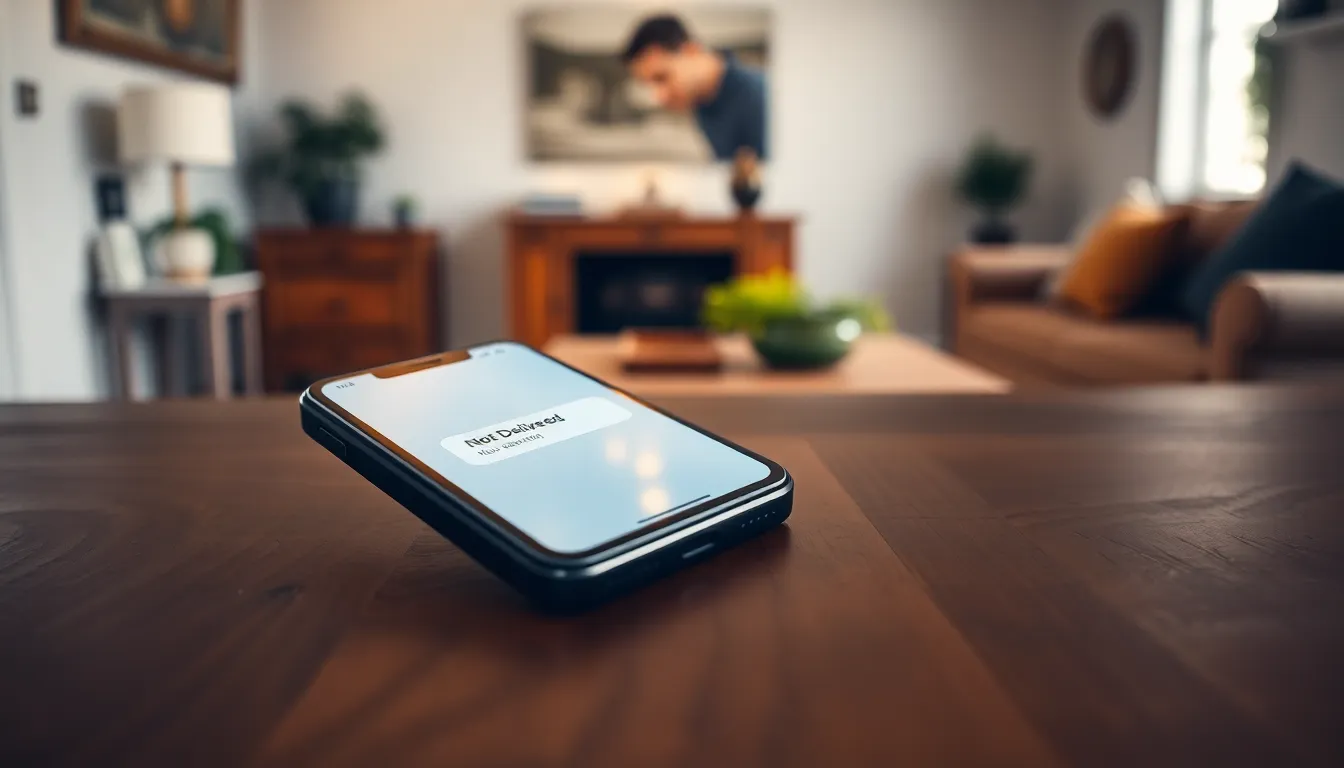Table of Contents
TogglePicture this: you send a message, heart racing with anticipation, only to be greeted by the dreaded “Not Delivered” notification on your iPhone. It’s like sending a love letter via carrier pigeon, only to watch it fly off into the sunset. Frustration sets in as you wonder whether your friend’s phone is on the fritz or if they’ve just ghosted you.
Understanding Message Status on iPhone
Understanding message status on an iPhone is crucial for effective communication. Messages typically display various statuses: Sent, Delivered, Read, or Not Delivered. Each status provides insight into the message’s journey.
“Sent” indicates that the message left the device but may not have reached the recipient yet. “Delivered” confirms successful transmission to the recipient’s device. “Read” signifies the recipient viewed the message if read receipts are enabled.
Several factors can cause the “Not Delivered” notification. Weak cellular signals or Wi-Fi connectivity issues create barriers in message delivery. Settings on the recipient’s device, such as Do Not Disturb mode or blocked numbers, may prevent reception as well.
Messaging apps like iMessage require the recipient’s device to be online for messages to be delivered. When both the sender and recipient possess an iPhone, messages use iMessage, benefitting from encryption and read receipts. Mixed device usage introduces protocols like SMS, which rely on cellular networks.
Errors can also stem from software glitches. Restarting the device or ensuring the operating system is updated often resolves these issues. Checking settings such as Airplane mode or network preferences can provide clarity.
Parents or individuals using family sharing may encounter status inconsistencies due to restrictions or settings. Familiarizing oneself with these features enhances communication effectiveness. Staying mindful of these variables allows better expectations regarding message delivery.
Common Reasons Your Message Doesn’t Say Delivered

Various factors contribute to the “Not Delivered” status on iPhones, impacting communication techniques. Understanding these issues can alleviate frustration and enhance messaging experiences.
Network Connectivity Issues
Weak cellular signal ranks as a primary cause behind undelivered messages. Areas with poor reception often result in messages failing to send. Wi-Fi connectivity also plays a role; intermittent connections cause similar problems. Problems may arise when networks experience congestion or outages. An efficient workaround involves switching between Wi-Fi and cellular data to check which works best. Checking for airplane mode settings is critical, as it disables any network connections. Resolving network issues requires verifying connectivity settings and ensuring they’re correctly configured.
iMessage vs. SMS
Differences between iMessage and SMS explain why messages sometimes don’t show as delivered. iMessage relies on internet connectivity to function, while SMS uses cellular networks. If the recipient isn’t connected to Wi-Fi or cellular data, iMessages cannot get delivered. Messages sent as SMS don’t provide delivery updates until the recipient’s network processes them. Just because a message appears sent doesn’t guarantee delivery, particularly when dealing with cross-platform messaging. Inconsistent delivery statuses arise from mixed device usage, especially when switching between Apple and non-Apple devices. Thus, understanding the distinction aids users in troubleshooting effectively.
Troubleshooting Steps
Follow these steps to address the “Not Delivered” message issue on an iPhone.
Checking Settings
Ensure that the iMessage feature is enabled in the settings. Access the Settings app, tap on Messages, and verify that iMessage is turned on. Next, check the recipient’s phone number or email address for accuracy. Confirm that the sender and recipient use the same messaging platform; iMessage requires internet connectivity while SMS utilizes cellular networks. Review restrictions in the Screen Time settings, especially for family sharing accounts. Examine Do Not Disturb mode on either device, as this can prevent notifications from appearing. Remember to check network settings too; enabling Airplane Mode and then disabling it can refresh connections.
Restarting Your Device
Restarting the device often resolves software glitches. Hold down the power button until the slider appears, then slide to power off. Allow the device to remain off for about 30 seconds before turning it back on. After rebooting, check for updates in the Settings app under General and Software Update. Installing the latest software can address unknown bugs impacting message delivery. Refreshing the messaging app by closing it and reopening may also help. Encourage users to clear their recent apps for better performance. This simple step frequently resolves delivery issues on various devices.
Additional Considerations
Addressing issues of message delivery on an iPhone can involve several additional factors. Understanding these nuances aids in enhancing communication.
Software Updates
Keeping the device’s software up to date plays a crucial role in ensuring proper messaging functionality. Bugs in outdated software can lead to failures in message delivery. Regular updates often contain fixes for known issues, enhancing overall device performance. Users can check for software updates by navigating to Settings, then tapping General and Software Update. Installing the latest updates minimizes potential disruptions caused by software glitches. Ensuring that the device runs on the most current version dramatically improves messaging reliability.
Apple Support Resources
Utilizing Apple Support resources can provide valuable assistance in resolving messaging issues. The official Apple Support website offers articles and troubleshooting guides tailored for various problems. Users can access help through the Apple Support app or directly through the website to find specific solutions. Engaging with Apple Support through chat or phone can provide personalized assistance. Communities of users often share their experiences and solutions on forums, which can complement Apple’s help. Leveraging these resources can lead to a quicker resolution of delivery-related issues.
Experiencing the “Not Delivered” status on an iPhone can be frustrating but understanding the underlying causes can significantly improve communication. By troubleshooting connectivity issues checking settings and keeping software updated users can often resolve these problems quickly.
It’s essential to remember that factors like network strength and device settings play a crucial role in message delivery. Utilizing Apple Support and engaging with user communities can also provide valuable insights. By addressing these aspects users can enhance their messaging experience and reduce the likelihood of encountering delivery issues in the future.




